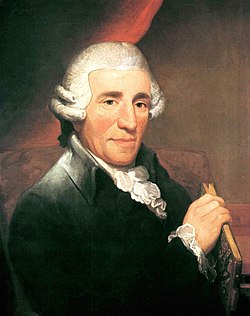
Joseph Haydn's Symphony No. 1 in D major, Hoboken I/1, was written in 1759 in Unter-Lukawitz, while in the service of Count Morzin. [a] [1] While it is reliably known that No. 1 was written in 1759, H. C. Robbins Landon cannot rule out that No. 2, [2] No. 4, [3] or both could have been composed in 1757 or 1758, which would make the D major symphony Haydn's third, rather than first.
Contents
Symphony No. 1 is scored for 2 oboes (or possibly flute), bassoon, 2 French horns, strings and continuo. [4] Like most of the early symphonies by Haydn and his contemporaries, it is in three movements:
The first movement opens with a Mannheim crescendo which is in contrast to the rest of the symphony, which is more Austrian in character. [5]
The first movement has "frequent passages", where the violas are "used with some ingenuity and quite separately from the bass line." [6]